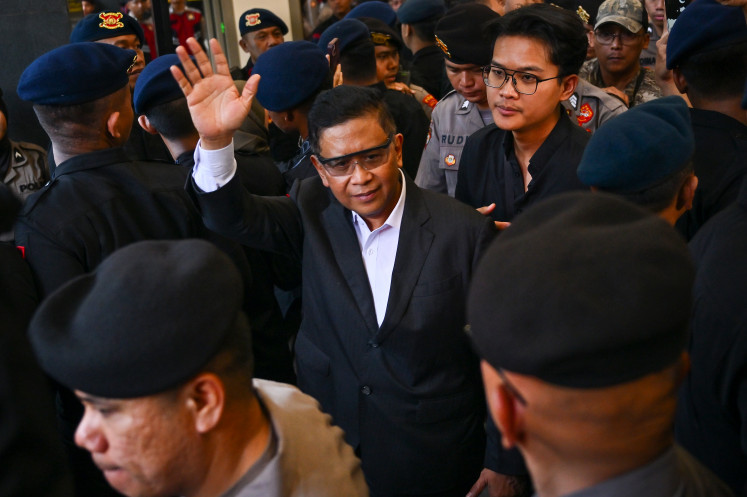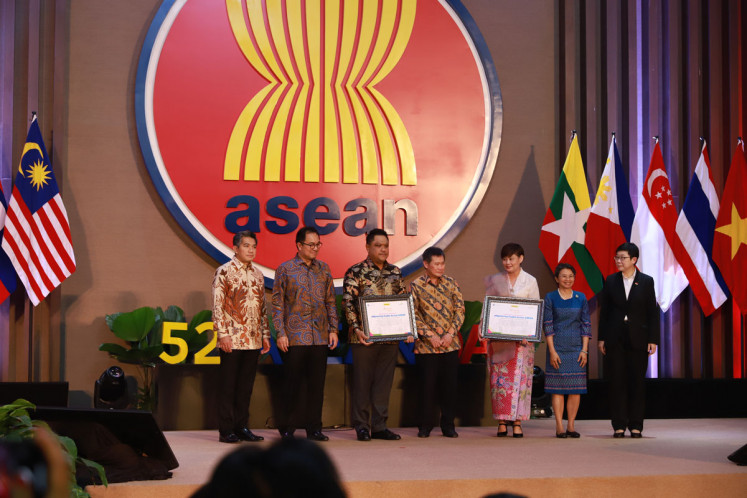Popular Reads
Top Results
Can't find what you're looking for?
View all search resultsPopular Reads
Top Results
Can't find what you're looking for?
View all search resultsThe three-body problem in geonomics
As much as the world might desire a crystal ball that sees beyond the uncertainty wrought by the current geonomic competition, AI and algorithmic forecasts can only do so much, as it is humans who ultimately determine the outcome through the decisions we make.
Change text size
Gift Premium Articles
to Anyone
A
sian economies are still anxiously assessing how to compete for trade with the United States after missing the Donald Trump administration’s Aug. 1 deadline for tariff negotiations.
The Philippines’ tariff rate for exports to the US is reportedly down to 19 percent. However, one Filipino lawmaker says it’s 6 percent. Indonesia’s rate is down to 19 percent; Vietnam’s is down to 20 percent.
Hours before the deadline, Malaysian, Thai and Cambodian leaders seemed to be on the cusp of reaching deals with the US. Meanwhile, Laos is bracing for stiff tariffs of up to 40 percent.
This is MAGA (“Make America Great Again”) economics in a nutshell. Washington has traded in a multilateral approach to hegemony for a “divide and conquer” strategy that makes smaller economies compete against each other for the superpower’s favor. Against the largest importer in the world, small exporters have no cards, as Trump might say.
As governments scramble to negotiate deals, businesses might have to close entire factories or shift to countries with lower tariffs. If current profit margins are too thin, higher tariff rates are likely to put further stress on the cost of doing business.
Vietnam, Cambodia and Bangladesh emerged as big winners from the first phase of the US-China trade war in the late 2010s. But Cambodia faced a tariff rate as much as 40 percent, compared with Bangladesh's 35 percent. On Aug. 1, Trump basically equalized tariffs by putting Cambodia and Bangladesh at 19 percent, versus Vietnam’s 20 percent.
This climate of fierce geoeconomic competition is ushering in a wave of uncertainty. Meanwhile, any attempt to use technology to stay ahead of the game might be in vain, even as the US doubles down on artificial intelligence policy.
Last month, the Trump administration released “America’s AI Action Plan”. According to him, “As [the US’] global competitors race to exploit these technologies [such as AI], it is a national security imperative for the United States to achieve and maintain unquestioned and unchallenged global technological dominance.”
In a unipolar order, the hegemon dictates the rules.
After World War II, the global economy was comparatively stable. Under Pax Americana, one set of rules governed free trade and capital flows. However, the world system wasn’t without contradiction. Europe and Russia began to wield more influence after recovering from the Second World War. The rise of China, India and emerging economies such as Indonesia and Brazil was also on the horizon.
During the Cold War, Mao Zedong divided the world into the “first world” of superpowers, the “second world” of advanced economies and the “third world” of nonaligned countries. One might mathematically approach this fragmentation through the N-body equation, more popularly fictionalized by Chinese author Liu Cixin in his science fiction novel, The Three-Body Problem.
When physicist Isaac Newton studied the motion of planets, he was able to predict the trajectory of two bodies mathematically. But the three-body problem has no elegant mathematical solution to predict the outcome of multiple-body gravitational interactions. Each body’s motion is influenced by the changing gravitational pull of the other two or more bodies, creating complex interactions that current mathematics cannot accurately explain.
The three-body problem illustrates science’s limitations, as well as the limitations of historically informed paradigms used to understand contemporary times and predict the future. AI stems from this paradigm, as it combines existing data, computing power and algorithms in the form of large language models (LLMs).
The US believes AI could shape the outcome of several geonomic puzzles. Will AI help MAGA return to the unipolar order? Is the bipolar order between the US and China stable? Will a multipolar order comprising three or more powers lead to conflict and more disorder?
National security thinkers posit that if they collect real-time data through social media and intelligence gathering, gain superiority in computing and apply the most advanced learning models, they can beat the opposition. If only life were that simple.
Chinese strategist Sun Tzu understood the importance of gathering intelligence.
Decision-making is difficult in a fast-changing environment plagued by misinformation, disinformation and information gaps. AI can use algorithms to generate “synthetic data”, but all data exporters know the fatal flaw of “garbage in, garbage out”. Bad data leads to bad decisions. Hence, there is no perfect AI solution.
The clash of civilizations and economies on a global scale is a system-wide competition between entangled systems that are not independent of one another. China, being an older civilization compared to the US, understands the need for resilient systems, whether they be supply chains or governing institutions.
Ultimately, these systems are underpinned by people and the planet we live on. After all, decisions are inevitably made by people, even if they use AI. Climate change only adds new risks, making outcomes even more unpredictable.
The world system will be shaped by how each competitor learns from mistakes or missteps and takes action to be more resilient against future shocks.
We have no algorithm to predict how the contest for the 21st century will unfold. As the Spanish poet Antonio Machado profoundly put it, “Traveler, there is no road, the road is made by walking.”
---
The writer is a distinguished fellow of the Asia Global Institute (AGI) and chairman of George Town Institute of Open and Advanced Studies (GIOAS) at Wawasan Open University.











